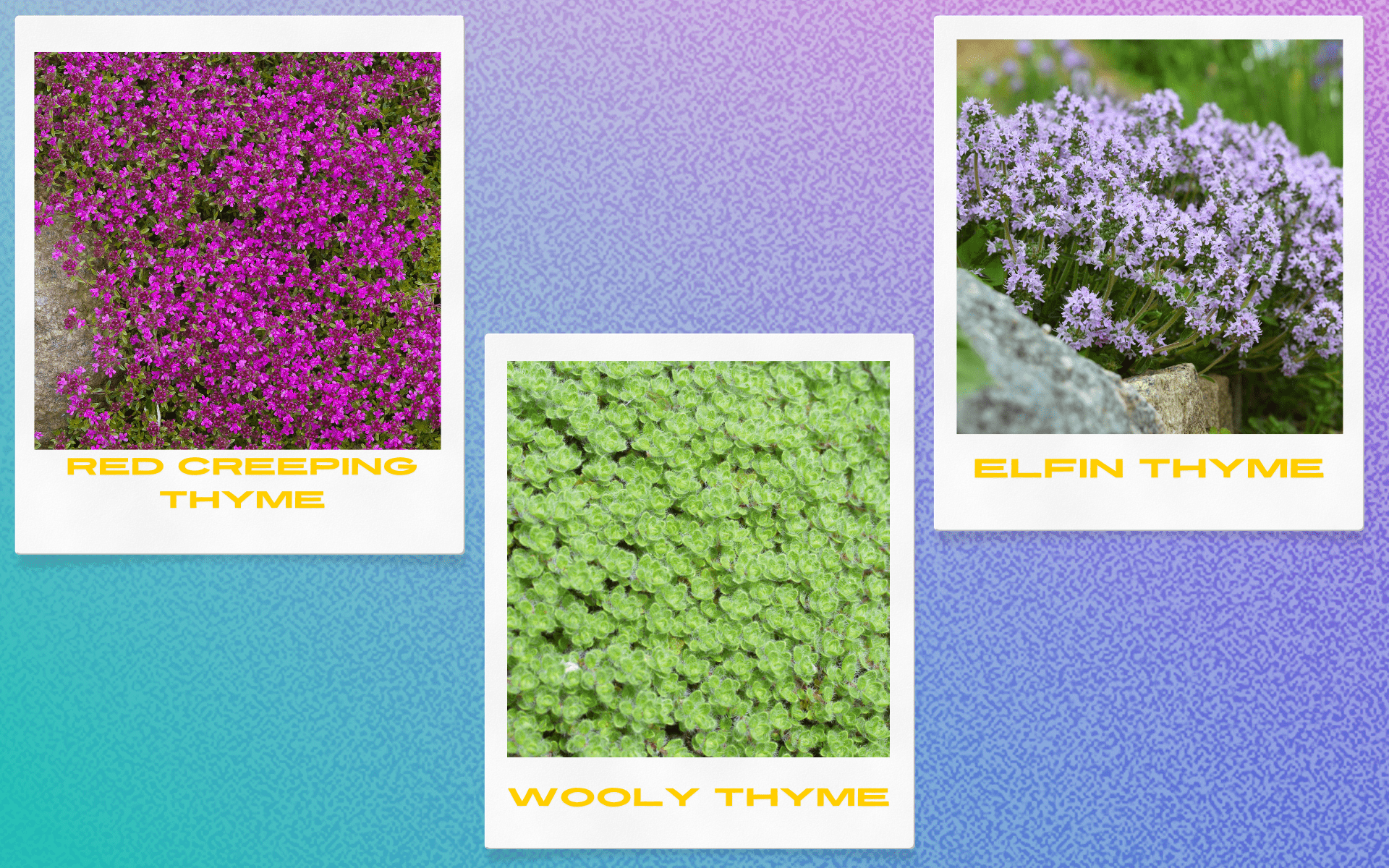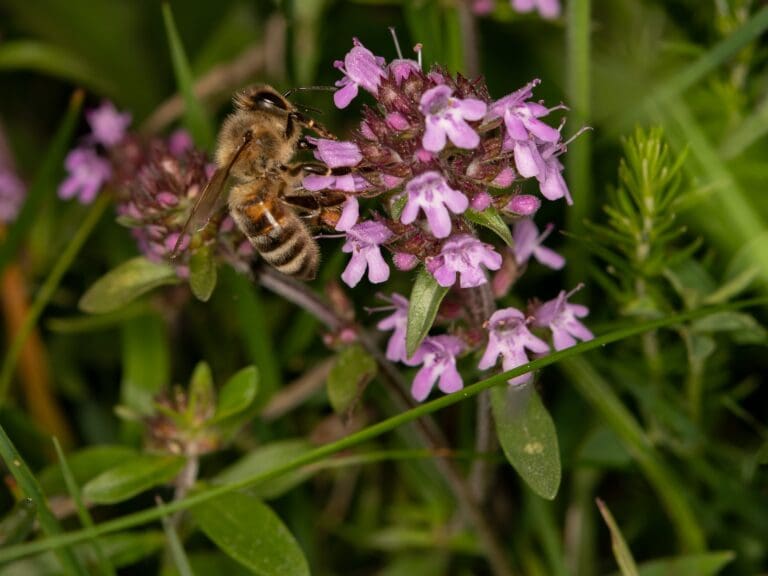Creeping thyme is a perennial native to northern Europe, western Asia, and northern Africa. It has a modest growth rate and can be replaced by turf grass. This low-growing plant has a lifespan of more than two years. Its fragrant blooms attract pollinators with abundant tubular blooms in vivid pink and purple from June to early September, creating a thick, colorful mat.
Thyme: An Alternative To Grass
Creeping thyme is one of the few plants that offers brilliant spring blooms, lovely covering, and minimal upkeep. This herbaceous plant, also called Mother of Thyme, can spread over time and form a dense carpet of fuzzy, delicate leaves. The majority of plant nurseries carry creeping thyme plants. Choosing a thyme ground cover is ideal for dry locations and areas with poor soil.
Creeping Thymes Varieties
Not every type of thyme will “creep.” Most can withstand deer and grow in challenging environments.
Red Creeping Thyme
Red creeping thyme is a popular ground cover variety known for its attractive red blooms. Its stem grows horizontally, forming new roots when it touches the soil instead of “creeping and spreading.
Wooly Thyme
Wooly thyme is a creeping thyme that grows quickly, tolerates foot traffic, and creates a lovely lawn.
Elfin Thyme
One of the tiniest thymes, Elfin thyme grows slowly, making it ideal for planting around locations like sidewalks and stepping stones that you don’t want fully covered in thyme.
Before selecting one, there are, of course, many more kinds to take into account. It’s recommended to ask a local landscaper for guidance on which types are most appropriate for your region.

What Factors Contribute to the Rising Popularity of Creeping Thyme Lawns?
Despite regular, tedious maintenance, many grass lawns can lose their lush green look and become patchy and unappealing. Creeping thyme is a viable evergreen alternative grass, offering numerous benefits.
Drought-Resistant
Creeping thyme lawns are drought-resistant and require less watering than traditional grass lawns.
No Mowing Necessary
Creeping thyme lawns don’t require mowing, but bushy types may be mowed once a year.
No Need to Replant
Classified as perennials–meaning they grow and spread year-round
Aesthetically Pleasing
Becomes a carpet of attractive lavender and pink flowers that last into the season.
Pleasant Aroma
Gives off a beautiful aroma, which can serve multiple purposes.
Attracts Pollinators and Repels Pests
The fragrance of creeping thyme flowers and nectar attracts bees and butterflies while repelling deer, rabbits, and mosquitoes.
Keeps Weeds at Bay
Thick growth prevents weeds from invading.
No Need to Fertilize
Creeping thyme lawns are low-maintenance and do not need fertilizer.
You Can Walk On It
Once established, thyme can be walked on, but not too much, especially when dry.
Potential Herb Garden
Thyme leaves can be used for various culinary purposes.
Downsides of Creeping Thyme
Thyme lawns are more expensive than grass and turf lawns and may require more labor to prepare and establish the ground.
Downsides include:
- Moderate to high initial cost due to higher labor requirements.
- Slow-growing in the first year, so it requires patience.
- It requires significant work for initial labor and soil preparation.
- Tolerates less foot traffic, but thrives around pavers or stepping stones.
- Flowers attract bees and may need regular mowing if you want to minimize them.
- Potential for woody growth if not mowed or pruned.
- Woody plants may need replacement with younger ones.

Caring Tips for Creeping Thyme
Light
Ensure at least six hours of full sun for optimal growth.
Soil
Tolerates poor soils, and prefers neutral to slightly alkaline conditions.
Water
Prefers dry to medium soil moisture, gradually reducing watering frequency to prevent root rot.
Fertilizer
Typically not needed, but balanced fertilizer can be beneficial in low-nutrient soils.
Temperature
Prefers dry, good airflow, but should be vigilant when temperatures get hot to prevent excessive drying.
How to Plant Creeping Thyme in Easy Steps
- Smother the Grass
- Test Soil and Apply Compost
- Choose Your Variety
- Sow the Seeds
- Water Consistently
- Prune or Mow 1-3 Times per Season
Reasons Why a Creeping Thyme Lawn May Not Be Right for You
Before ordering thyme plugs from local landscapers, consider your location and desired xeriscaping area. Thyme is not winter-hardy in USDA Hardiness Zones 3 and lower but is suitable for Zones 4 through 10. For shaded lawns, creeping thyme may not be suitable. Thyme needs four to six hours of direct sun exposure daily to prevent wilting. Poor drainage or soggy lawns can lead to root rot, causing the thyme to lose its roots.
Creeping Thyme Lawn FAQs
Are there different colors of creeping thyme?
Creeping thyme is a great group of ornamental ground covers enjoyed for their wonderfully textural mat-like stems and foliage and the showy flowers that bloom in colors of white, pink, rose, and rose-red. The blooms rest right on top of the flat branches that create a blanket of color in full bloom.
Which creeping thyme spreads fastest?
Creeping pink thyme, with almost an inch of stem between its sets of leaves, grows much more quickly than, say, a pink chintz thyme or a wooly thyme whose leaves are very close together. The increased stem segment also provides a greater rooting zone for the thyme allowing it to spread faster.
Is creeping thyme toxic to dogs?
So, is Creeping Thyme a dog’s bane? Not exactly. It’s not classified as highly toxic, but it’s not a canine superfood either. In moderation, it’s unlikely to cause harm, but in larger quantities, it can lead to gastrointestinal distress.
How long does it take for creeping thyme to spread?
Creeping thyme takes a while to become established, and the plants usually don’t grow much during their first year. However, established plants can spread quickly and stretch 12 to 18 inches wide by their third year.













